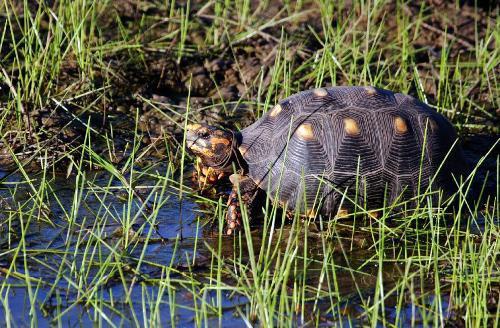Bruno de Oliveira Ferronato
This project aims to investigate natural history aspects of Amazon freshwater turtles and to start an environmental education program within Asháninkas communities in Pasco State, Central Peru.

Threatened species, in particular those like the Red-footed Tortoise (Chelonoidis carbonaria). © Cassiano Zaparoli
Egg and meat consumption are one of the main reasons for the decline of Amazon freshwater turtles. Species once abundant, as yellow-spotted sideneck turtle (Podocnemis unifilis), is now classified as a vulnerable species. This project proposes research on reproductive biology, diet and population aspects of Amazon turtles, as well as implementation of an environmental education program, in the territory of two Asháninka indigenous communities, in Central Perú.
Animals will be captured in lagoons and streams using fishing nets and baited traps, and with motorboat and hand dip nets in Azupizu River. Biometric measurements will be done in captured turtles, sex will be determined by external morphological characteristics and animals will be marked by notching marginal scutes. Population density will be estimated by the turtles recaptured, through the Mark-Recapture Method. The animals’ diet will be assessed through the stomach flushing technique. We will evaluate frequency of occurrence, numeric frequency and volume percentage. We will look for potential nesting zones, as river beaches and lagoon edges, according to local people information. During the reproductive period we will check the quantity of nests, measurements of nest cavity and egg dimensions, incubation period, incubation success and nest predation
Workshops will be held for all age groups concerning the project objectives, activities and turtle biology explanations. Printed materials will be prepared according to age. An artificial nesting beach will be prepared in each community, with local people help and they will accompany the process since the incubation to the release of the animals.
The results from this investigation will clarify natural history information of the species in the Tropical Andes region and it will help in future turtles’ conservation strategies within the indigenous communities.